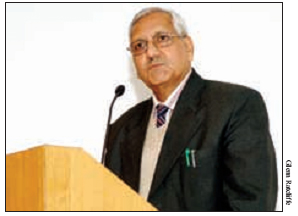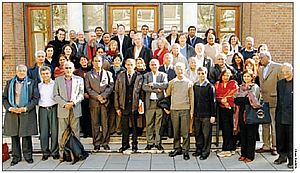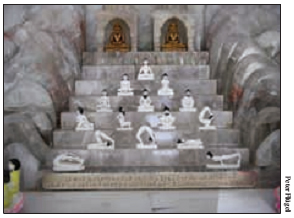
Centre of Jaina Studies Newsletter: SOAS - University of London
The 10th "Jubilee" annual Jaina Studies Workshop at SOAS was an intensive day-long affair that included debate, inspiring findings and a sumptuous visual bonanza for all who attended. Although few in the audience shared the specialized training in Jaina art and architecture of the presenters, all benefited from the experience, and were left with the cheery impression of being privileged insiders for a day into the very animated and fertile field of Jaina art.
Although the themes of the presentations varied widely, they can for the purposes of this review be loosely grouped into two broad categories: 1) historical investigations, and 2) interpretive explorations of art and meaning.
In the first category of historical exploration, we had the presentation by Avadhanula Vijaya Kumar Babu, (Osmania University, Hyderabad) who communicated the results of an excavation of the structural remains of a presumed "Jaina Stūpa" in Andhra Pradesh by the team of T.V.G. Shastri in an effort to establish the importance, and antiquity of, this area for Jain studies. Max Deeg (Cardiff University) presented a titillating account of possible Jaina influences on the works of the Syriac Bardesanes of Edessa, and on Mani. Exploring textual sources from a perspective of cultural coherence, Deeg argued that influence of Jainism on these 3rd century thinkers is a distinct possibility. R. Uma Maheshwari (JNU) presented an intriguing study of the ancient Jaina Digambar agriculturalist community of Tamilnadu, called "Nainars". She argued that their story-telling, passed down from generations, reflects a constant theme of socio-religious marginalization, and a preoccupation with maintaining social boundaries. Maheshwari queried the historicity of some of the community's more disquieting stories, suggesting that their centrality for the Jaina community may very well point to actual events in history.


Gerd J.R. Mevissen (FU Berlin) deepened our knowledge of Jain history by bringing to light the little known Jaina influence on North Bengal artistic expression of the 11th and 12th centuries. He convincingly argued that the sculptures from the time period (although only a small number remain) possess iconographic features that reveal influences of Hindu and Buddhist imagery, yet were ingeniously adapted and integrating in uniquely Jain ways. Janice Leoshko's (University of Texas) presentation likewise contributed to our knowledge of the early spread of Jainism by exploring Jaina art and architecture in Orissa (Udayagiri-Khandagiri), believed to date from as early as the second century BCE. Leoshko argued that the Jaina art of Orissa remains an understudied area that, if plumbed, has tremendous potential to shed light on the centuries-long Jain religious experience of eastern India. Lisa Nadine Owen (University of North Texas)'s presentation on the Jain stone carvings of Tamil Nadu was a stimulating intellectual and visual treat. Owen's theoretical focus was that of 'sacred space' how it was ideologically conceived, maintained and ritually engaged within Jainism. Her presentation raised many fascinating questions as she queried the stone relief carvings of Jina images in the village of Kalugumalai, elucidating their resonances with, and divergences from, more traditional sites of devotional activity. Alvappillai Valuppillai (University of Arizona) treated the religious polemics of Tamil Jainism as a window into the survival of the minority tradition. Jainism, along with Śaivism, Vaiṣṇavism, and Buddhism fought it out ideologically, from the 7th century onwards, as each strove to establish the legitimacy of their own religious path and, concomitantly, their socio-political and economic footing.
The remaining presentations, employing more of an interpretive methodology, specifically focused on the central role that art (or art forms) plays in the construction of religious and cultural meaning.
Nalini Balbir (University of Paris), gave us a fascinating presentation of invitation scrolls (vijñaptipatra) as a distinctively Jain cultural and aesthetic phenomenon. The scrolls, in and of themselves, contain masterful aesthetic qualities and offer historians a wealth of detail. But they also provide us with a uniquely Jain cultural artefact, one that emerged out of distinctive Jain cultural and religious needs (namely, the communication between householders and honoured renouncers). Balbir's paper expertly established the central role that art plays in cultural perpetuation and communication.

Robert J. Del Bontà delighted his audience with the passion and erudition he brings to his work. His presentation on the Bāhubali colossus at Śravaṇabeḷgoḷa was no exception; he received rapt attention from an audience very familiar with the image, but likely unaware of the vast repertoire of distinct traditional narratives that surround it. Del Bontà's exploration of diverse cultural and sectarian (Śvetāmbar/ Digambar) narratives revealed not only the diversity of meanings which have been imputed to the image, but also confirmed the unavoidable conclusion that meaning is inescapably tied to narrative.
Christoph Emmrich (University of Toronto) took the audience on a fascinating and multifaceted journey into the history of Tamil Jainism via an engagement with contemporary members of the Jaina community of Kanchi, and their architectural heritage. Cultural self-interpretations are constructed in negotiation with the remains of ancient temples, and through the delicate, and (to some extent) inevitably "imagined" terrain of a long religious history a history which includes cultural suppression, intolerance, as well as voluntary assimilation and cultural appropriation. Reminiscent of Del Bontà's argument, we saw that meaning, created at the intersection between narrative and material culture, is never fixed. Peter Flügel (SOAS) took the theme of meaning and material culture in Jainism to its highest point the summit of Sammeta Śikhara, the tradition's most important pilgrimage site. The paper, rich in detail and insight, explored the veneration of both 'relics of use' and 'relics of commemoration' in Jain ritual culture. Equally important is the symbolic import of the Jina's bone-relics (a form of representation found in literature alone, since the physical remains of the Jinas are believed to reside in the heavenly realms, outside of the reach of human beings). Flügel argued for an analytical distinction between sites of empowerment (associated with special events) and sites of commemoration (which are arbitrarily chosen), claiming that their differentiation is critical to a fuller understanding of Jaina architecture, art and ritual practice. Furthermore, Flügel argued that the absence of bone-relics of the Jinas (though not of Jaina ācāryas as his report in Jaina Studies, issue 3 shows) effectively eliminated the possibility of a ritual culture focused on "objectified charisma" (as developed within Buddhism) and instead led the way to a ritual culture centred on the "routinisation of charisma". This proclivity for symbol over object dovetails with the Jain "master narrative" which associates worldliness with corporeality, and its transcendence with the incorporeal. Flügel insightfully contended that the difficult pilgrimage to the distant site of Sammeta Śikhara, the peak of which contains only the "intangible", is an affirmation of Jain soteriology par excellence; reaching its heights affirms and effectuates, ritually, the Jain path of liberation. And yet, ironically, the "body" is never truly absent. As Flügel noted, the motivation to make the pilgrimage is to establish bodily contact with a place where the once-embodied Jinas inhabited. Olle Qvarnström and Niels Hammer (University of Lund) presented findings from their preliminary exploratory forays into the Jaina caves at Ellora. While the paintings differ in style and motif, Qvarnström and Hammer argued that, taken together, they reveal an overarching and ideologically informed narrative, as well as an affiliated affective "grammar" (intriguingly, one of "joy"). These findings raise interesting questions about inter-religious influences, and contribute to a rich and nuanced understanding of Jain history and meaningmaking. John Henry Rice (University of Pennsylvania) offered a fascinating analysis of the intersection between material culture and ideology in his discussion of temple building in medieval Karnataka. Rice demonstrated how the study of temple architecture is revelatory not just of a distinctive religious ideology, but an underlying sociopolitical reality. The shift in Jain temples from the longitudinal bastis, with their symbolism of cooperation and symbiosis, to the monumental caturmukha bastis, with their symbolism of universal kinship, is reflective of their growing political ascendancy in the 16th century.
Prakash Shah (Queen Mary College, London) delighted the audience with a visual extravaganza of Jain ritual practice in Britain. His analysis of Jain devotional activity at the opening of the Śvetāmbara Jain temple near Potters Bar, north of London, emphasized both its cosmological significance (as diaspora Jains recreate ritual and sacred space outside of India) and its "symbolic capital", reflecting a community that has achieved a measure of economic security, as well as confidence in its socio-religious identity in pluralistic Britain.
It seems fitting to end this review with Maruti Nandan P. Tiwari's impressive and wide-ranging overview of the state of the field of Jain art and architecture in his keynote SOAS Annual Jaina Lecture, which took into consideration both its historical and interpretive dimensions, and suggested avenues for fruitful future study. He warned against the trend to ghettoize Jaina studies, and advocated a more holistic approach to the field which would situate Jaina art within its broader South Asian context, of which it forms an integral part. In a similar vein, he argued that Jaina art cannot be contained within a framework of renunciation, and scholars must be able to make sense of its worldly dimensions as well. Other areas for profitable study in the field of Jaina art include what Tiwari referred to as its "social-engineering" (namely, socio-economic foundations of its patronage) as well as the pervasive role that nature (fauna and flora) plays in its artistic representation.

 Dr. Anne Vallely
Dr. Anne Vallely